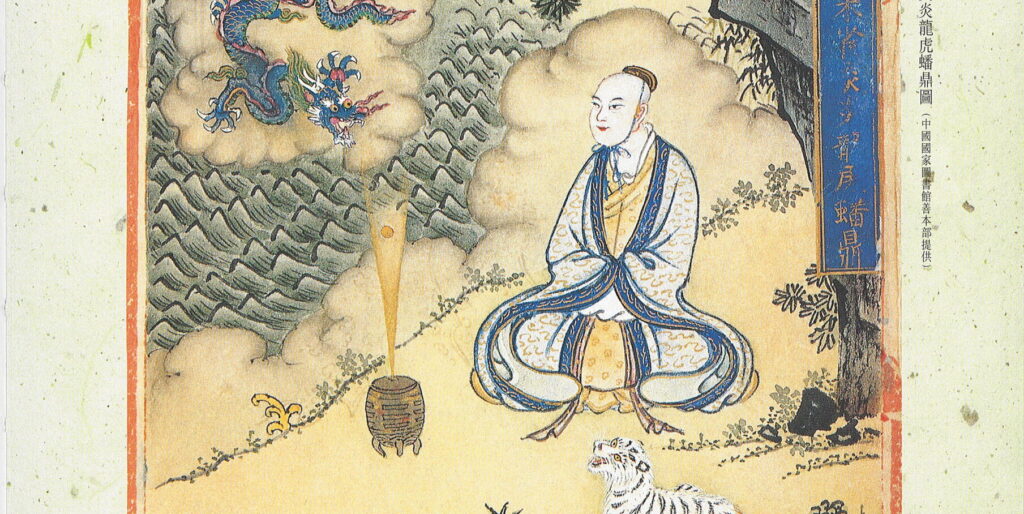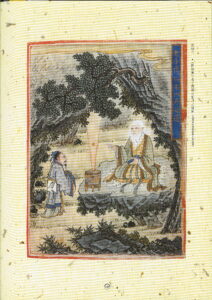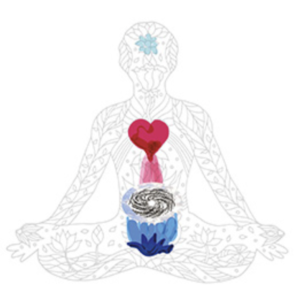
Navigating Modern Life with Taoist Wisdom
Alchemy for Inner Transformation
An article by Carsten Dohnke
(published in the Magazine of the Taiji & Qigong Network, Dec. 2019)
(This article is from December 2019, written for the magazine of the Taiji and Qigong Network in Germany)
A few days ago I was asked the following question in a Youtube interview: What do people need in this modern age of digitalisation? My answer was: a connection with their body, the possibility for an inner healing process and the connection to their own resources. This is exactly the essence of Inner Alchemy. And to put it in a nutshell: This important current of Taoism still indirectly influences almost all styles of Qigong and Taoist Meditation today.
What does “Inner Alchemy” actually mean?
When you hear the term Inner Alchemy, it first sounds like the Middle Ages. But a brief definition makes it more interesting: Inner alchemy means that through the focus of our mind we are able to direct and centre our life force and change emotional states. This allows us to experience a deep connection to ourselves and to life. In other words, with the help of our mind we can induce biochemical processes in the body that change our entire state of being. Besides self-healing and vitality, the followers of alchemy are concerned with one goal: they want to gain access to their true nature through the purifying effect of meditation. This access is supposed to form the basis for a mystical experience – a oneness with life or the experience of boundless freedom. Among other things, this is also defined as liberation from the “ego” or from all suffering. However, many schools of the Taoist tradition also aspired to the goal of a “light body”. Similar to the Buddhists, the idea here is that this energetic body can continue to exist in another dimension after death. In Taoism, by the way, there were two other orientations: shamanistic currents that sought connections to higher worlds, and various groups that mainly pursued health and longevity. We also find both of these in today’s qigong.
And what does “Outer Alchemy” mean?
 In ancient China, Inner Alchemy was opposed to Outer Alchemy for centuries. Alchemy in general is defined as ‘the scientific study of chemical substances’, ‘which focuses on the transformation and refinement of substances’. The main focus of external alchemy, which also existed in the Occident, was to prolong life or even achieve immortality through herbs, the ingestion of special minerals, but also substances such as mercury. This direction was very influential for a long time, because people in ancient China were exposed to extreme climatic conditions. Also, life expectancy was not very long. They therefore looked for supportive sources of strength that could strengthen the body and at the same time expel inner cold, wetness or heat. However, as we now know, this direction soon dissolved – the followers did not tolerate the mercury well. Due to the parallel existence of both currents, practitioners of Inner alchemy were also inspired to search for helpful herbal formulas to deepen their meditative practice. In addition, the basic ideas of Outer Alchemy led to the development of pills and medicines in Eastern and Western medicine. In the latest endeavours of many researchers from Silicon Valley, even the entire line of Outer Alchemy is experiencing a new flowering: they are now actually searching for a formula for eternal life.
In ancient China, Inner Alchemy was opposed to Outer Alchemy for centuries. Alchemy in general is defined as ‘the scientific study of chemical substances’, ‘which focuses on the transformation and refinement of substances’. The main focus of external alchemy, which also existed in the Occident, was to prolong life or even achieve immortality through herbs, the ingestion of special minerals, but also substances such as mercury. This direction was very influential for a long time, because people in ancient China were exposed to extreme climatic conditions. Also, life expectancy was not very long. They therefore looked for supportive sources of strength that could strengthen the body and at the same time expel inner cold, wetness or heat. However, as we now know, this direction soon dissolved – the followers did not tolerate the mercury well. Due to the parallel existence of both currents, practitioners of Inner alchemy were also inspired to search for helpful herbal formulas to deepen their meditative practice. In addition, the basic ideas of Outer Alchemy led to the development of pills and medicines in Eastern and Western medicine. In the latest endeavours of many researchers from Silicon Valley, even the entire line of Outer Alchemy is experiencing a new flowering: they are now actually searching for a formula for eternal life.
The Basics of Inner Alchemy
If we now take a closer look at the basics of Inner Alchemy, things get very interesting. For they are based on the principles of today’s therapeutic work and also approaches from coaching:
the principle of self-acceptance
the principle of self-organisation
the connection with one’s own resources
All this is based on the connection with our body, or formulated for our time: the rediscovery of our body as a basis for inner transformation and spiritual growth. I am now deliberately starting from the back: I can only put out a fire in my house when I am at home. It is the same with inner processes or emotional issues. The Taoists recognised the connection between body and mind very early on. Traditional Chinese medicine, which is directly connected to the teachings of Taoism, clearly shows, especially in the teachings of the five phases of change, how emotions such as anger, fear, but also excessive joy, etc. are directly connected to the states of our organs. The problem is, however, that most people have little connection to their bodies. We are often tense, stressed or exhausted and “circle like prisoners” in our thought worlds and emotions.
Even in ancient China, the followers of Inner Alchemy therefore always used exercises such as Taiji, Tao-Yin or practices of today’s Qigong to cultivate their life force, to strengthen themselves and to experience a state of inner balance. We usually know that. But now there is a crucial point: different levels of our being require different frequencies of healing. In order to perceive my inner fears, to process old feelings or to experience a state of being connected to life, I need access to my cellular structure and to my unconscious. Movements and body training are therefore only seen in Inner Alchemy as a basis for diving into deeper layers of our being in meditation.
This immersion in oneself first feels as if one is sinking or sitting down inwardly in one’s body. This creates a feeling of open space and inner expanse, combined with an inner arrival and timelessness. In Inner Alchemy one initiates this process, among other things, by consciously connecting oneself with the forces of heaven and earth and then feeling the the lower “dantien”, the energy center in the abdominal cavity between the navel and the kidneys. This new inner space is the basis for all deeper processes. Life itself can now shine through. And every practice that follows now comes from a deeper level of being, free from the controlling patterns of the ego. One of the basic practices of Inner Alchemy from this inner arrival is then the so-called “Nei Guan”, the inner contemplation. This usually means a perception of the “landscape of the inner organs”. Simple variants of this practice can be found today in many qigong styles as “inner smile” or “journey through the body”, etc.
Self-Acceptance and Self-Organisation
The key to any introspection is self-acceptance. By now lovingly directing my mind to my lungs or liver, for example, and perceiving with an inner embrace what I  feel there or see inwardly, a process of integration begins – a healing on a physical and emotional level. Because almost every illness or chronic stress situation is unfortunately also based on the fact that I inwardly deny, reject or no longer love myself. This denial not only takes me away from feeling myself and my aliveness. It also weakens my immune system and leads to an inner splitting off. By now embracing what is and simply being present, the principle of self-organisation of life can work: Change occurs because the natural force of life is not disturbed. Self-organisation always works when there is an open space combined with inner presence. Using the example of the lungs, this can feel like this: perhaps I perceive how the lungs become wider or larger or how their inner colour changes – in Taoism, a white colour is assigned to them. Or I can feel how the lungs become more vital, how inner images arise or feelings such as unprocessed sadness come to the surface.
feel there or see inwardly, a process of integration begins – a healing on a physical and emotional level. Because almost every illness or chronic stress situation is unfortunately also based on the fact that I inwardly deny, reject or no longer love myself. This denial not only takes me away from feeling myself and my aliveness. It also weakens my immune system and leads to an inner splitting off. By now embracing what is and simply being present, the principle of self-organisation of life can work: Change occurs because the natural force of life is not disturbed. Self-organisation always works when there is an open space combined with inner presence. Using the example of the lungs, this can feel like this: perhaps I perceive how the lungs become wider or larger or how their inner colour changes – in Taoism, a white colour is assigned to them. Or I can feel how the lungs become more vital, how inner images arise or feelings such as unprocessed sadness come to the surface.
Connecting with Inner Resources
This alone is a process of self-healing and integration. And it is now consciously strengthened in the alchemy approach by connecting with inner resources or forces in meditation. Our most important inner resources are the love of our heart and our libido as a source of inner healing power and creativity. Not without reason are both important ingredients of many Hollywood movies. In addition, energies of nature and life in which we are embedded as human beings are also important resources. In Taoism and Qigong, these are generally referred to as the forces of heaven and earth or the “Qi of nature”.
The connection with inner resources is based on one of the most important laws of life: Every deep change needs energy. This is already the case at the cellular level. And especially in our modern times, when many people are stressed and overwhelmed or carry unhealed illnesses and inflammations, it often needs an additional force to enable a process of healing and integration. After all, it is significant that many people fall ill on holiday – finally the body has enough energy to regenerate.
Love and Libido merge to a unified Healing Force
The fusion of our Love and Libido into a single Healing Power is now a renowned practice in Inner Alchemy. Bringing together the potency of the heart and the libido, is more accessible than it may appear.
For example, one imagines a lake in the belly that is nourished by an inner source at the bottom of the pelvis. At the same time, one visualises that the love of the heart shines like a sun on this inner lake. Supported by a gentle, repeated tightening of the pelvic floor, a harmonious blending of these energies occurs: Heart and sexual energy  converge within the abdomen, forming an internal healing force (1). This healing energy can then be consciously directed towards specific organs or glands. In advanced stages of practice, this method generates a refined Qi, akin to an ‘inner steam,’ which nourishes and rejuvenates each cell from within, propelling the practitioner into heightened states of consciousness.
converge within the abdomen, forming an internal healing force (1). This healing energy can then be consciously directed towards specific organs or glands. In advanced stages of practice, this method generates a refined Qi, akin to an ‘inner steam,’ which nourishes and rejuvenates each cell from within, propelling the practitioner into heightened states of consciousness.
The result is a deep contemplation of oneself, the dissolution of the physical body or even the slowing down of the ageing process. The interesting thing is that one not only activates resources, but unites important life forces into a new energy. The alchemists speak here of narturing and refining our life force and the above practice is just one example of this. The concept behind this is based on the fundamental idea of the alchemists that we “lose our way in life”. As adults, we move further and further away from the natural state of a child, lose contact with ourselves and exhaust our powers. The unification of different energies is supposed to give us the possibility to counteract this process and at the same time to return to our origin.
Actually, everything is similar to legendary Gaulish warriors “Asterix and Obelix” : In the inner cauldron of the abdomen you collect different essences for a magic potion. And this potion not only has a healing and vitalising effect, it also helps us to arrive at ourselves and opens a door into higher states of consciousness and wisdom.

Inner Alchemy in Everyday Life
Asterix was overwhelmed by the fact that the Romans wanted to occupy Gaul. Nowadays, we are overwhelmed by the demands of modern life. In this sense, Inner Alchemy hits the nerve of our time, even if it comes from a different social and historical context. For we need not only relaxation, but above all love, healing, an arrival at ourselves and a connection with the forces of life. This enables new ways out of exhaustion, overwork and self-negation. For everyday life, moving qigong can be combined very well with practices such as the “Inner Smile” or the “Healing Sounds” – exercises that are also common in many qigong styles. Even after a short period of practice, one can quickly vitalise and relax and at the same time strengthen the immune system. Deeper practices need a certain amount of perseverance. However, if you are willing to participate in an intensive course over several days, you can experience profound changes that open new doors in your life and last for a long time. The energy field of the group can be a great help. Well, let`s get started.
- An important addition here would be that the energy of the pelvic floor is directly connected to the kidney energy. In addition, the pelvic floor is a gateway to the yuan qi (a deeply restorative energy), the qi of the earth and a foetal state of being of primordial trust. So the sexual energy is actually only a part of the whole.
A few simple exercises of taoist Inner Alchemy for home.
Before wrapping up, let’s consider the practical steps for initiating your journey into the inner alchemy of Taoism at home:
Morning Routine: Begin your day with a brief meditation, focusing on your inner center. After that, connect with the energies of heaven and earth to establish a harmonious energy foundation for the day. At the end let these enegies shine and melt in your center.
Stress Management: Incorporate the ‘Inner Smile’ practice into your daily routine. During moments of stress, visualize a warm, soothing light spreading from your heart, releasing tension and fostering calmness.
Evening Ritual: Prior to bedtime, engage in a ‘Journey Through the Body’ meditation. This practice helps detach from the day’s events, preparing both body and mind for rest and rejuvenation.
Connection Between Pelvic Floor Energy and Kidney Energy: Explore the meditation technique to strengthen kidney energy. Focus on your lower dantian and visualize energy spreading downward into the pelvic floor, then upward into the kidneys, fostering revitalization and stability. End with som minutes of silence in your dantian
Qi Gong for the Pelvic Floor: Incorporate specific Qi Gong exercises targeting the pelvic floor to enhance strength and activate energy in this area. This practice supports the health of your kidney energy system.
By integrating these practices into your daily life, you’ll embark on a journey of inner transformation and vitality. Happy exploring!

